cocoaPods打包的静态库
cocoaPods管理自己的静态库供其它人下载使用(直接使用上一篇用cocoaPod打包的静态库)
(1) 创建github仓库
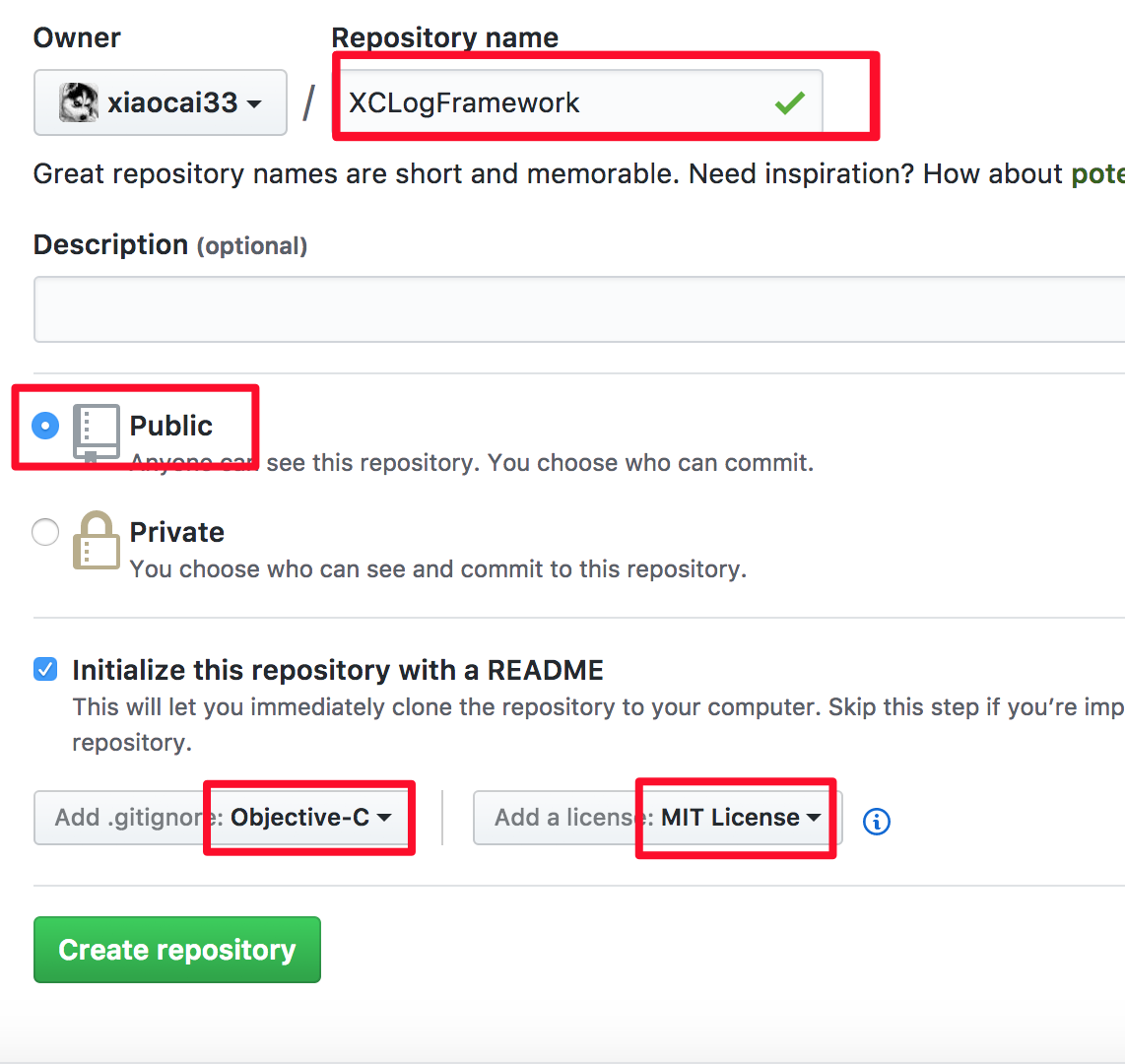
(2) 下载仓库到本地

(3) 将打包好的framework放到项目中
(4) 终端提交到github上
git add .
git commit -m “install”
git push origin master
(5) 打标签, 并提交到github上
git tag 1.0.
git push origin 1.0.
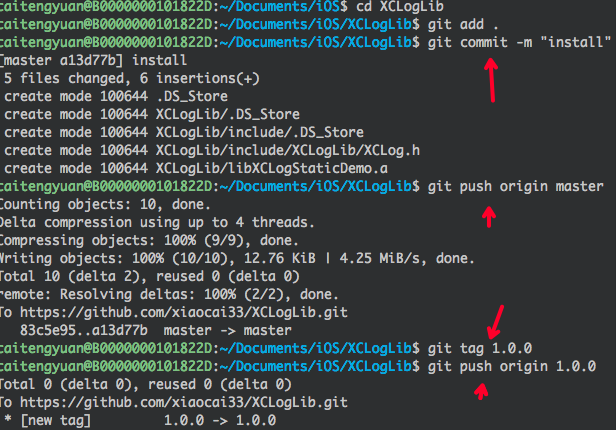
二 (1) 在工程根目录初始化一个Podspec文件, 最好与项目同名

(2) 配置文件
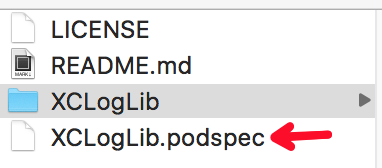
#
# Be sure to run `pod spec lint XCLogLib.podspec' to ensure this is a
# valid spec and to remove all comments including this before submitting the spec.
#
# To learn more about Podspec attributes see http://docs.cocoapods.org/specification.html
# To see working Podspecs in the CocoaPods repo see https://github.com/CocoaPods/Specs/
# Pod::Spec.new do |s| # ――― Spec Metadata ―――――――――――――――――――――――――――――――――――――――――――――――――――――――――― #
#
# These will help people to find your library, and whilst it
# can feel like a chore to fill in it's definitely to your advantage. The
# summary should be tweet-length, and the description more in depth.
# s.name = "XCLogLib"
s.version = "1.0.0"
s.summary = " XCLogLib test demo" # This description is used to generate tags and improve search results.
# * Think: What does it do? Why did you write it? What is the focus?
# * Try to keep it short, snappy and to the point.
# * Write the description between the DESC delimiters below.
# * Finally, don't worry about the indent, CocoaPods strips it!
s.description = <<-DESC
A Test XCLogLib Demo. where you can put your description.
DESC s.homepage = "https://github.com/xiaocai33/XCLogLib"
# s.screenshots = "www.example.com/screenshots_1.gif", "www.example.com/screenshots_2.gif" # ――― Spec License ――――――――――――――――――――――――――――――――――――――――――――――――――――――――――― #
#
# Licensing your code is important. See http://choosealicense.com for more info.
# CocoaPods will detect a license file if there is a named LICENSE*
# Popular ones are 'MIT', 'BSD' and 'Apache License, Version 2.0'.
# #s.license = "MIT (example)"
s.license = { :type => "MIT"} # ――― Author Metadata ――――――――――――――――――――――――――――――――――――――――――――――――――――――――― #
#
# Specify the authors of the library, with email addresses. Email addresses
# of the authors are extracted from the SCM log. E.g. $ git log. CocoaPods also
# accepts just a name if you'd rather not provide an email address.
#
# Specify a social_media_url where others can refer to, for example a twitter
# profile URL.
# s.author = { "Cai Tengyuan" => "tycai1@baidu.com" }
# Or just: s.author = "Cai Tengyuan" # ――― Platform Specifics ――――――――――――――――――――――――――――――――――――――――――――――――――――――― #
#
# If this Pod runs only on iOS or OS X, then specify the platform and
# the deployment target. You can optionally include the target after the platform.
# # s.platform = :ios
s.platform = :ios, "8.0" # When using multiple platforms
# s.ios.deployment_target = "5.0"
# s.osx.deployment_target = "10.7"
# s.watchos.deployment_target = "2.0"
# s.tvos.deployment_target = "9.0" # ――― Source Location ―――――――――――――――――――――――――――――――――――――――――――――――――――――――――― #
#
# Specify the location from where the source should be retrieved.
# Supports git, hg, bzr, svn and HTTP.
# s.source = { :git => "https://github.com/xiaocai33/XCLogLib.git", :tag => "#{s.version}" } # ――― Source Code ―――――――――――――――――――――――――――――――――――――――――――――――――――――――――――――― #
#
# CocoaPods is smart about how it includes source code. For source files
# giving a folder will include any swift, h, m, mm, c & cpp files.
# For header files it will include any header in the folder.
# Not including the public_header_files will make all headers public.
# s.source_files = "XCLogLib", "XCLogLib/**/*.{h}"
#s.exclude_files = "Classes/Exclude"
s.vendored_libraries = "*/libXCLogStaticDemo.a"
# framework is
#s.vendored_frameworks = '*/XCLogStaticDemo.framework' # s.public_header_files = "Classes/**/*.h" # ――― Resources ―――――――――――――――――――――――――――――――――――――――――――――――――――――――――――――――― #
#
# A list of resources included with the Pod. These are copied into the
# target bundle with a build phase script. Anything else will be cleaned.
# You can preserve files from being cleaned, please don't preserve
# non-essential files like tests, examples and documentation.
# # s.resource = "icon.png"
# s.resources = "Resources/*.png" # s.preserve_paths = "FilesToSave", "MoreFilesToSave" # ――― Project Linking ―――――――――――――――――――――――――――――――――――――――――――――――――――――――――― #
#
# Link your library with frameworks, or libraries. Libraries do not include
# the lib prefix of their name.
# # s.framework = "SomeFramework"
# s.frameworks = "SomeFramework", "AnotherFramework" # s.library = "iconv"
# s.libraries = "iconv", "xml2" # ――― Project Settings ――――――――――――――――――――――――――――――――――――――――――――――――――――――――― #
#
# If your library depends on compiler flags you can set them in the xcconfig hash
# where they will only apply to your library. If you depend on other Podspecs
# you can include multiple dependencies to ensure it works. s.requires_arc = true # s.xcconfig = { "HEADER_SEARCH_PATHS" => "$(SDKROOT)/usr/include/libxml2" }
# s.dependency "JSONKit", "~> 1.4" end
(3) 创建账号(如果已经创建过, 省略)
pod trunk register 邮箱 联系人 --description="描述" --verbose
创建成功会收到邮件,进邮箱验证
pod trunk me 可查看trunk信息
(4) trunk push之前要先验证
pod spec lint XCLogLib.podspec
出现 XCLogLib.podspec passed validation表示通过了
如果只是waring通过
pod lib lint --allow-warnings #强制忽略
如何 想看错误详情
pod spec lint XCLogLib.podspec --verbose
如果有错, 看下配置文件哪里错了.

(5) pod trunk push 这个有点耐心, 需要会时间
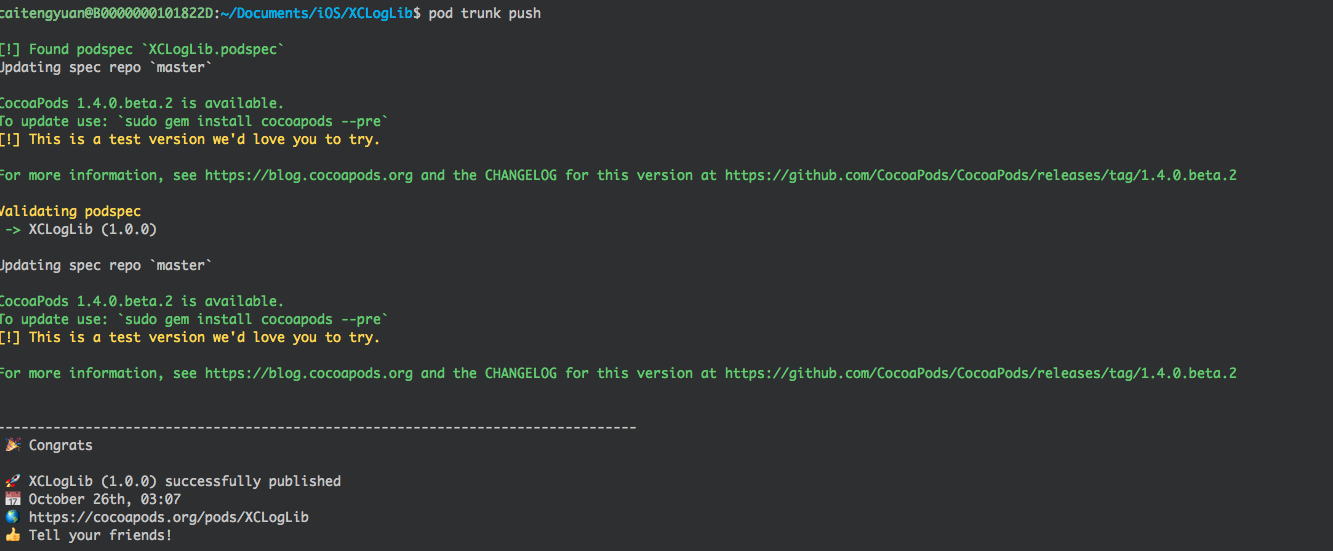
(6) 成功后pod search XCLogLib

如果搜索不到, 请看上篇博客介绍.
(7) 在其它项目的 Podfile 中引用:
platform :ios, ‘8.0' 注意版本要大于静态库支持的最低版本
pod ‘XCLogLib'
或者 pod ‘XCLogLib’, '~> 1.0.0’
这样就可以在demo中引用头文件
#import “XCLog.h”
然后调用静态库的方法了.
如果是framework的框架, 则需要将配置文件的
s.vendored_libraries = “*/libXCLogStaticDemo.a"
改为 (注意路径)
s.vendored_frameworks = ‘*/XCLogStaticDemo.framework'
即可, 这里不再演示
三 xcode项目支持pod
终端:
cd path #到项目目录
pod init fileName.Podfile #创建 Podfile 文件
打开文件在其中添加需要依赖的库
例:
pod ‘XCLogLib’
例子:
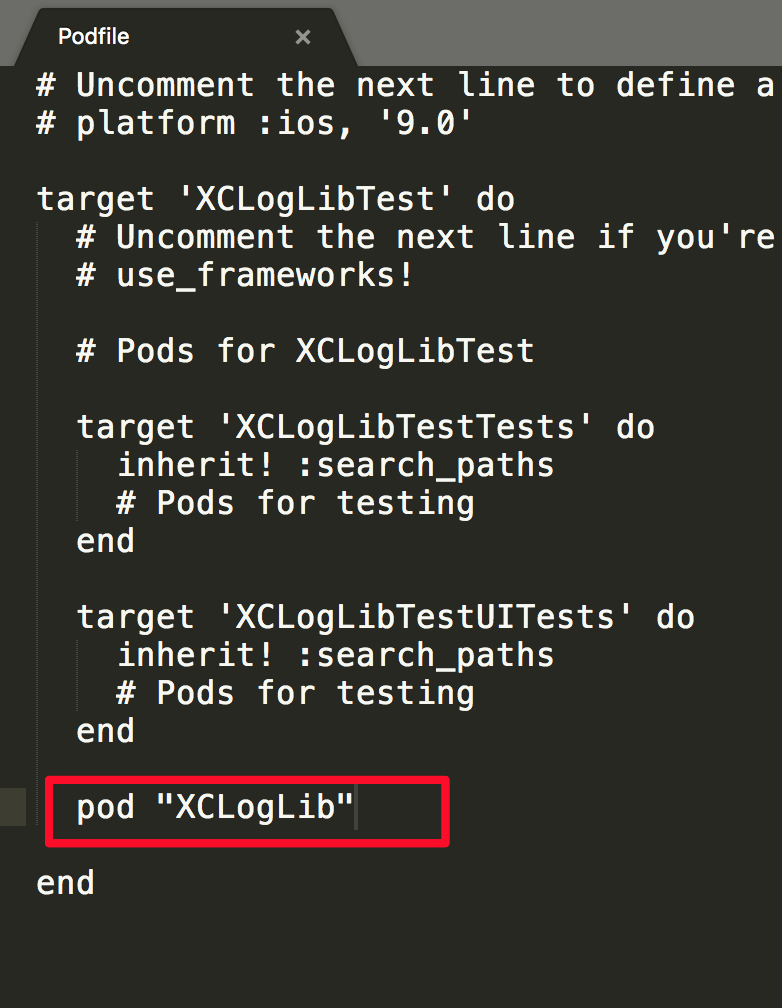
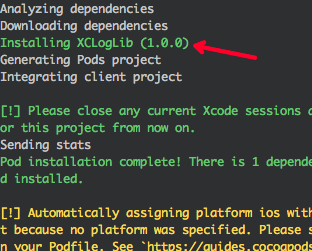
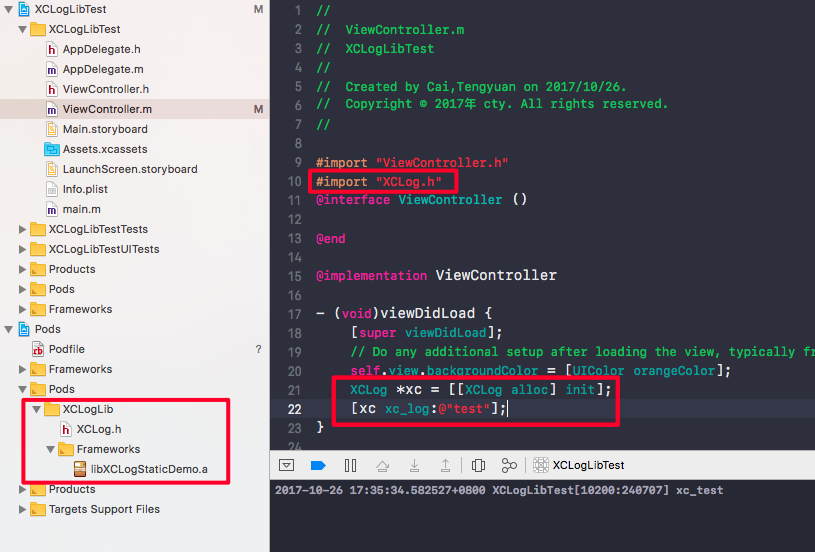
cocoaPods打包的静态库的更多相关文章
- iOS中打包.a静态库
1.新建.a静态库工程 需要选择Static Library静态库工程模板新建工程,如下图: 新建静态库工程 实现需要打包的类,如下图: 实现需要打包的类 2.设置需要暴露的头文件 添加Headers ...
- iOS - .a静态库的打包(包括打包的文件中用到了一些别人的三方库和分类的处理)
一.概念篇 什么是库? 库是程序代码的集合,是共享程序代码的一种方式 根据源代码的公开情况,库可以分为2种类型 开源库 公开源代码,能看到具体实现 比如SDWebImage.AFNetworking ...
- iOS开发——打包静态库与Framework
最近老是需要做接口给别的客户,就顺便把打包的过程也写一下吧! 一.静态库 静态图里面只能是纯文件,里面不能再有第三方打包的静态库,也就是说,静态库不能打包静态库.这个用的比较多,一般自己公司写出来的东 ...
- iOS打包静态库(完整篇)
1. 什么是库? 所谓库就是程序代码的集合,是共享程序代码的一种方式. 2. 库的分类 根据程序代码的开源情况,库可以分为两类 开源库源代码是公开的,你可以看到具体实现.比如GitHub上比较出名的第 ...
- (一〇二)静态库(.a)的打包
库是代码的集合,根据代码公开程度,分为开源库和闭源库. 其中闭源库主要包括静态库和动态库,是经过编译的二进制文件,看不到具体实现. 静态库的拓展名是.a或者.framework,动态库则是.dylib ...
- 李洪强iOS开发之静态库的打包一
李洪强iOS开发之静态库的打包一 //静态库一般做一下几种事情 //1 工具类 算法逻辑 新建工具类LHQTools 定义类方法 + (NSInteger)sumWithNum1: (NSIntege ...
- iOS静态库.a总结(2017.1.24增加脚本打包方法)
修改于:2017.1.24 1.什么是库? 库是程序代码的集合,是共享程序代码的一种方式 2.根据源代码的公开情况,库可以分为2种类型 a.开源库 公开源代码,能看到具体实现 ,比如SDWebImag ...
- ios打包静态库
1. 什么是库? 所谓库就是程序代码的集合,是共享程序代码的一种方式. 2. 库的分类 根据程序代码的开源情况,库可以分为两类 开源库源代码是公开的,你可以看到具体实现.比如GitHub上比较出名的第 ...
- 【转】iOS动态库和静态库的简要介绍
静态库与动态库的区别 首先来看什么是库,库(Library)说白了就是一段编译好的二进制代码,加上头文件就可以供别人使用. 什么时候我们会用到库呢?一种情况是某些代码需要给别人使用,但是我们不希望别人 ...
随机推荐
- Python自学笔记-logging模块详解
简单将日志打印到屏幕: import logging logging.debug('debug message') logging.info('info message') logging.warni ...
- NOIP初赛 之 哈夫曼树
哈夫曼树 种根据我已刷的初赛题中基本每套的倒数第五或第六个不定项选择题就有一个关于哈夫曼树及其各种应用的题,占:0-1.5分:然而我针对这个类型的题也多次不会做,so,今晚好好研究下哈夫曼树: 概念: ...
- java.security.InvalidKeyException: Illegal key size
今天遇到一个奇怪的问题. 自己做的加签验签功能已经没有问题了,本地测试通过,同事放到服务器上测试也没问题. 然后我将包放到自己搭建的环境上,会报这样一个错误: java.security.Invali ...
- scala配置intellij IDEA15.0.3环境及hello world!
1. Intellij IDEA Scala开发环境搭建 Intellij IDEA 15.0.3 默认配置里面没有Scala插件,需要手动安装,在Intellij IDEA 15.0.3 第一次运行 ...
- 【源码】canal和otter的高可靠性分析
一般来说,我们对于数据库最主要的要求就是:数据不丢.不管是主从复制,还是使用类似otter+canal这样的数据库同步方案,我们最基本的需求是,在数据不丢失的前提下,尽可能的保证系统的高可用,也就是在 ...
- AspectCore中的IoC容器和依赖注入
IOC模式和依赖注入是近年来非常流行的一种模式,相信大家都不陌生了,在Asp.Net Core中提供了依赖注入作为内置的基础设施,如果仍不熟悉依赖注入的读者,可以看看由我们翻译的Asp.Net Cor ...
- 在 Ubuntu 14.04 中安装 Pepper Flash Player For Chromium
转自:http://blog.csdn.net/ygzhong000/article/details/26160953
- Linq标准查询操作符
Linq的出现让代码简洁了不少.之前在项目中基本都在使用它,但是没有完整的整理过,今天借这个周末,将其进行整理,方便后期对其的使用.Linq的操作可以分为聚合,连接,转换,元素操作符,相等操作,生成 ...
- Linux入门(2)——Ubuntu16.04安装wineQQ
http://www.ubuntukylin.com/application/show.php?lang=cn&id=279 下载得到wine-qqintl.zip 解压得到wine-qqin ...
- ALSA和Pulseaudio
小记一下,Deadbeef如果使用ALSA作为音频输出的话,会导致其他说有使用pulseaudio的程序[如Chrome]没声音.....[但是SMplayer使用ALSA的话不会...]
